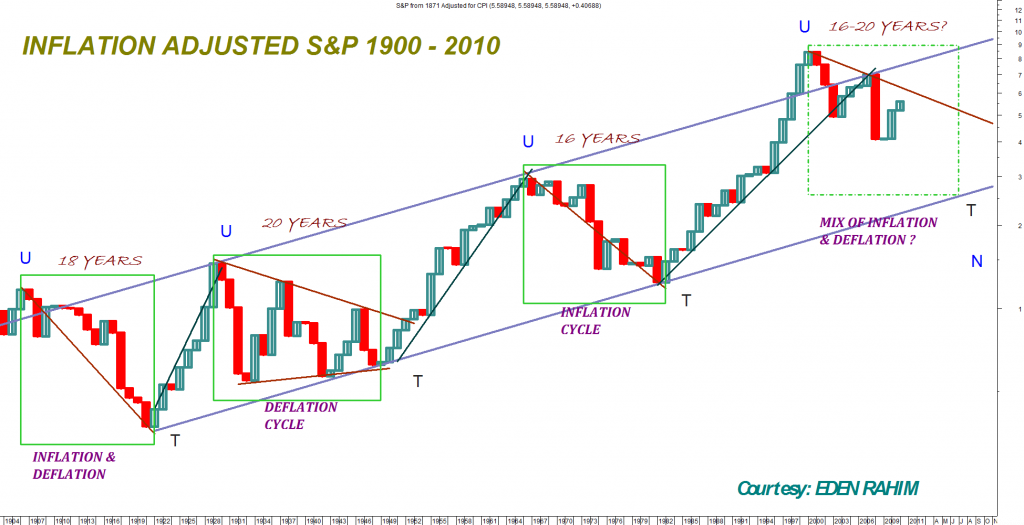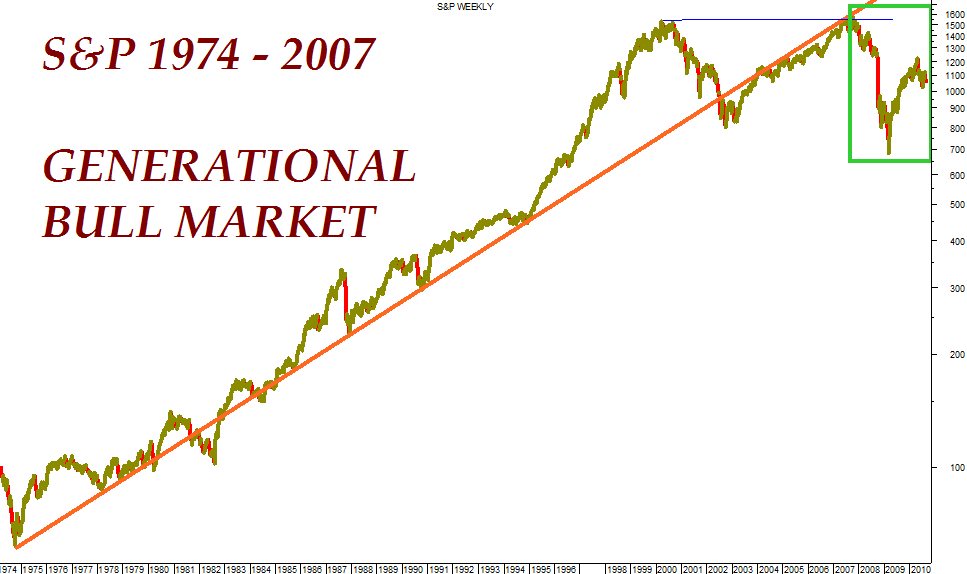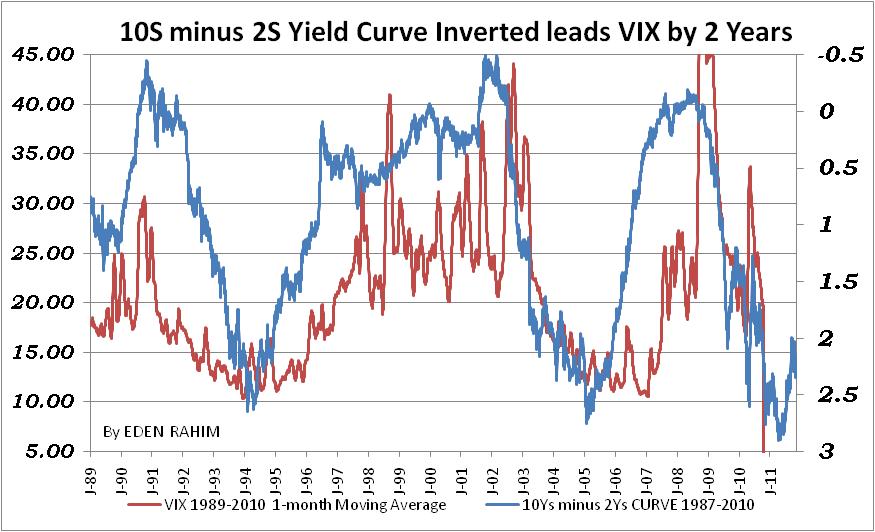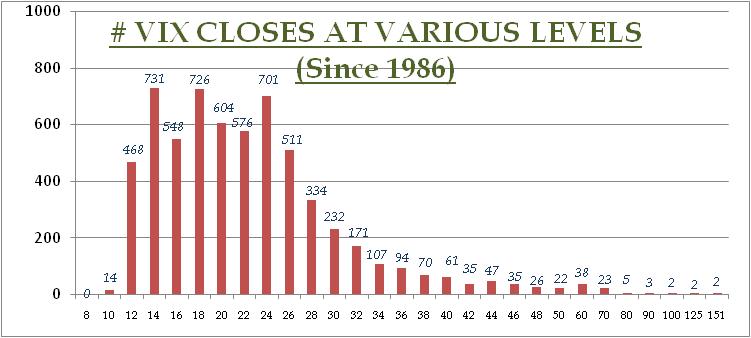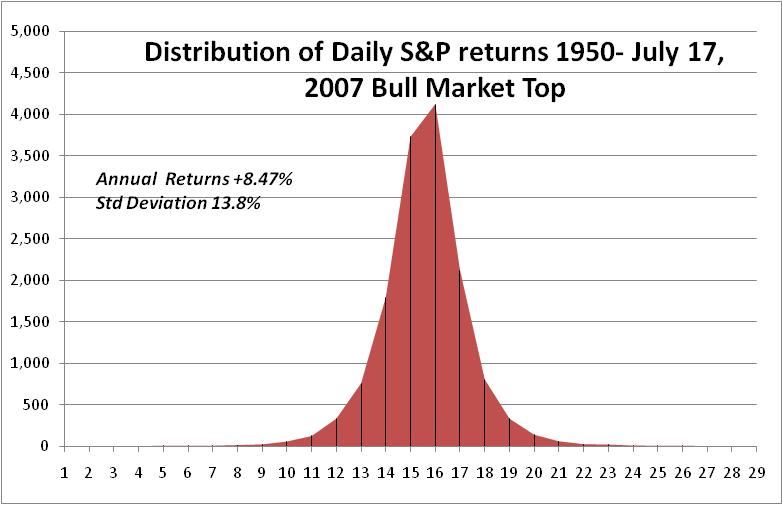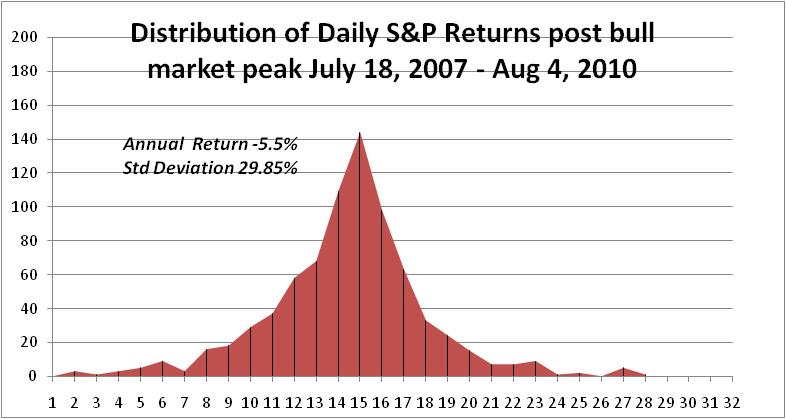Markets ebb-and-flow in big cycles and your investing approach has to adapt to these changing currents. In this interview you’ll learn about how markets move from decade long periods where risk is embraced to where risk must be managed. Revealing his encyclopaedic knowledge of the market history, this interview is a must read for all capital market enthusiasts.
Biography: Eden Rahim, a Portfolio Manager at Jov Investment Inc, is part of the team that designed and introduced the Horizon’s Gold Yield ETF to be listed on the TSX, that overlays a covered-write program on a gold portfolio. He is involved in designing ETF hedging and income solutions to protect institutional portfolios and capture premium income.
His investment career began with RBC in 1994 as a Derivative Analysis. His responsibilities included creating structured notes on LME metals and Biotech baskets, and hedging multiple asset classes (stocks, bonds, currencies) through crises such as the Peso, Referendum, Bre-X, Asian, and Dot.com bust using options and futures strategies. He also executed strategies to enhanced returns by capturing premium in Dividend, Income, Growth, Precious Metals and Global Bond funds that contributed to their top quartile performance. As a senior VP & PM, he managed the RBC Growth Fund and Canadian Growth Pool to a 5-Star rank that was earned over a 5 year period through mostly difficult markets, returning +9.5% CRR over a period the market declined. This was achieved by utilizing a variety of Hedging and Income strategies to protect against risky scenarios, and add to returns. Additionally, as a Biotech Analyst with a top quartile 9 year performance of over +26% CRR, Options hedging strategies were essential to managing the considerable “blow-up” risk characteristic of the sector. Subsequently, he managed the Taliesin Multistrategy Hedgefund (2005-2009), the JOV North American Momentum fund (2008). Eden won the TD Bank/ Globe&Mail Investment Challenge in 1991. After his undergrad in Molecular Genetics at University of Toronto (1986), Eden was a Business Analyst at CDS until 1994.
Eden blogs at The Road Less Traveled
Q: If markets ebb-and-flow in big cycles and one should alter their investing approach to adapt to these changing currents (i.e buy and hold doesn’t work), in what ways specifically (indicators/signals, tools etc.) do you go about identifying the turning points of cycles?
A: Thank you for inviting me to participate in this forum for diverse investment opinions. It’s been hectic, but I am delighted to outline my view of what I think are tectonic shifts the investment landscape is undergoing – both for investors and the industry.
I am a student of market history, and have compiled a collection of books, newspapers, magazines and data covering markets going back to the South Sea Bubble in 1720. As much as I hate invoking this cliché, what is clear is that the ‘more things change, the more they seem to stay the same’ – at least every couple of generations – about the time it takes us to unlearn the lessons of our Great Grandparents. There was an excellent book written back in 1997, The Fourth Turning, that quantified this. As such, each market cycle favors certain leaders and investment styles. The 1860s, 1910s, 1970s and 2000s favored Inflationary themes. The 1920s, 1950s, 1980s-90s favored Disinflationary themes. The 1880s, 1910s, 1930s, 1970s & 2000s were range-bound markets with multiple bull and bear markets that rewarded Asset Allocators and Trading.
So the $64,000 question is what is in store for the 2010s. What we do know is that we are entering this period with extremely bullish sentiment on the favorable themes of the past decade, namely Precious Metals, Resources (Crude, Metals, Uranium, Rare Earth), and Emerging and Frontier Markets. What we also know from history is that each decade gives way to new leaders that are under-invested in the way resources were a decade ago and proceeds to unwind the crowded trades, in the way that Technology was a decade ago, or the Nikkei the decade before that, or Resources the decade before that. What this decade’s new leaders will be, I don’t have a clue. I can guess that the entire planet is adapting and innovating to consuming less energy in every aspect of our lives and businesses, so whatever facilitates that secular trend will likely have the wind at its back. But that is only a guess – it may be something else completely under the radar right now. In 2001, few knew that Steel or Uranium would be huge themes in the decade.
A decade ago, capital was pouring into Servers and Broadband when what would be needed instead was more energy exploration and refinery capacity, and companies that facilitated credit expansion to consumers and housing. New Economy portfolio managers were Stars, and Resource PMs were getting fired. The pendulum has swung to the opposite extreme. You know who the Stars are now. A decade before that, the Japanese model was the envy of business schools and investors the world over. Two decades later, the Nikkei languishes down 69% off that peak. So yes, big cycles have much to teach us about what might possibly unfold next, even if it’s the assurance that ‘What has been, will no longer be’. The 2008 crash ushered in a consumer debt liquidation and deleveraging cycle. That doesn’t end in a couple of years when reverting to the mean. That trend rose for the past 5 decades.
These transitions are always associated with volatility since one crowded group is peaking, and capital begins to flow elsewhere, first as a trickle then turning into a torrent later in the decade, once the trend becomes widely recognized – as current trends already are. It’s not a painless process. That transition requires new skills, new approaches to managing risk, new mindset and sequestering your attachment to rules learned under very different conditions. Those old rules are no longer as reliable a compass in a post 2008 world.
When the generational bull market began in 1982, it penalized the traders that prospered in the prior range-bound decade, and rewarded the few that saw only blue skies ahead – a reversal of what it did in 1968. Similarly, Momentum investing, as an example, performs well when markets are rising. But we have seen how they get eviscerated when the markets morph into bears during the past decade. So the question going forward is what skills will be beneficial in the years ahead that will add Alpha to fund managers? It’s certainly no longer going to be due to standard industry mantras such as a) Buy-and-Hold, b) Relative Performance, c) Pursuit of Capital gains, d) Diversification into other asset classes, and e) The Fed has got our back.
The chart below shows the inflation adjusted cycles for the past 110 years. The corrective period generally lasted 16-20 years. I think we are 10 years into the current cycle. The Nikkei is in its 20th year. Gold lasted 20 years from 1980 to 2000, and has risen every year since.
Another trend emerging in the investment community is the inroads ETFs are making into traditional pools of investing capital such as trading, mutual fund investors and retirement funds. This trend will inevitably migrate to more passive pools of capital such as Pension, Endowment, and Defined Contribution plans. For two decades Mutual Funds attracted investors at considerable cost. They achieved this on the promise that they can provide expertise and outperformance in exchange for fees. But with 80% of managers either matching or underperforming there benchmarks, the fee premium looms large in reducing long term performance. Mutual Fund Assets are 20 times larger than ETF assets in Canada, and since water flows downhill, expect Fees on mutual fund assets to converge with ETF Fees, which are typically 1/5th to 1/10th Mutual Fund fees, with added liquidity and tax benefits. That will trigger significant changes in this industry over the next few years. In the 1970s, the advent of Money market funds revolutionized Deposit taking and Fee spreads at banks, pressuring the cheap source of funds their model was built on. The same might happen at mutual funds.
The investing public is more knowledgeable and empowered than ever as investing has been democratized – as has been so many other professional functions in our society. That is why for those mutual funds sitting on their hands and hoping asset prices rise 50% to offset 50% fee pressure just to hold on to assets, is not a game plan. Imagine if assets unthinkably ever fall again, then it only compounds the pressure on firms with a high fixed cost base.
How are fund companies going to make assets more productive? How will they generate returns in a meandering sideways market? Stock picking has been commoditized as well, so where will the added value to unit holders come from? How do funds distinguish themselves from thousands of fund clones and increasingly lower cost ETFs?
Q: The obvious question that follows is how do you the investing/economic landscape currently and how do you envision the next few years unfolding?
A: I recently completed a study on what markets typically do in years following the initial 2-3 year surge coming out of major bear markets that were -50% or greater. There were six examples going back to 1835. If the prior bear market was -50% to -60% as the recent one was, then the market typically rebounded about +100% over the next 2-3 years (1843-45, 1878-81, 1938-39, 1975-76), then either moved into a broad multiyear sideways range of 5-10 years (4 times) or rolled back over and went back down to the prior lows (1939-1942, 2008-2009). Even for Bears that were down over 70%, the rebound was 150%-200% because of the much lower base, but they also then went into multiyear trading ranges. In all cases, the outcome seemed to be the same. Maybe this steroid induced market will be different. Who knows. But for the few fund companies that realize the Fed was not able to save the market from a crash in 2008, they might plan for the opportunity to generate Alpha in a range bound market, and develop an edge on competitors.
Fed policy has enabled the investment industry to hold on to the old rules a bit longer by penalizing every kind of risk aversion and rewarding speculative risk taking. Unlike under Reagan when tax laws were changed to benefit entrepreneurial risk taking and capital investment that was the foundation of a two decade boom, the current policy benefits speculative bidding up of commodities and favors outflows to emerging economies. Notice where all the white hot IPOs are occurring.
In contrast, Corporations and Consumers have adjusted their behavior, having painfully learned from the crash that credit can be cut off for no reason when banks get scared. That memory is now etched in their psyche. Accordingly, corporations have used this rebound to cut expenses and raise as much cheap debt as they can hoard, borrowing below their cost of dividend. Consumers in the US have also learned the downside of the credit cycle, which the Fed had insulated them through prior cycles, impeding the corrective feedback mechanism, enabling the problem to grow exponentially.
The moral hazard created by persistent Fed intervention that biases market behavior in favor of the less productive type of risk taking is symptomatic of what the US Forest Service discovered about stamping out bush fires. They realized their well-intentioned success from stamping out bush fires early, only paved the conditions for even larger, far more destructive bush fires later on. Essentially, by suppressing bush fires, itself a natural phenomenon, it allowed older, dryer trees to survive thus growing taller and preventing younger greener less incendiary trees from making headway. It also caused the underbrush to accumulate because it wasn’t being burned away by smaller bush fires. The result? Older forest with dryer underbrush that accumulated in much larger amounts, that once ignited, quickly became out of control. In a nutshell, the Federal Reserve’s well-intentioned interventions that kick the can down the street, leaves the necessary work of the market undone.
Q: Markets have endured 3 years (2007-10) of extreme conditions, down -56% then up +70%. What do you think about relying on the markets to bounce back or tactical asset allocation as strategies?
A: After a decade of being rattled, clients want stable returns, hence the rush for yield; they want high predictability and low volatility. The next time the market turns down, these issues will come to the forefront and investors will be less patient than they were in either 2000-2003 or 2008-2009. While there are steps fund managers can take to mitigate this risk, most don’t or choose not to take those steps. Farmers take these steps to hedge uncertainty to smooth out crop prices and delivery, and cheapen their cost of funding; Companies cope with operational volatility by hedging risks to produce predictable earnings – blue chip companies such as Southwest (fuel), Coke (currencies & sugar), Merck (currencies & clinical outcomes). Banks out of necessity hedge their multiple risks but Canadian asset managers generally do not. They rely on markets to bounce back as their key strategy to offset bad periods, rather than hedge either volatility or protect from negative returns. Maybe they fiddle a bit with cash levels and the mix of bonds vs equities, but that is about it.
Q: Eden, what most investors want now, especially after the volatility of the last 10 years is stable returns with high predictability and low volatility. Can you talk about the importance of managing risk in portfolios to mitigate surprises?
A: One of my favorite macro indicators is the lead signal the yield curve provides in anticipating the volatility cycle. The 10s-2s Yield Curve anticipates changes in Volatility by 2 years. In 2006, I wrote and presented repeatedly about a rising volatility cycle coming in 2007-2008. I was a costly 6-months early, as measured by my under water short positions, but when it came, it did so in historic style. Well it is again pointing to a rising volatility cycle from mid-2011, which is associated with falling asset prices. We’ve already had a generational move in volatility in 2008 when VIX went to 100, so the next cycle is likely to be standard move to 40-50 and be localized. Furthermore, with the Fed’s foot on the neck of short rates, the yield curve is no longer able to telegraph as reliable signals given it cannot flatten as much as it did in the past.
The chart below shows how the distribution of VIX follows Power Laws and not a normal distribution. Per Bak showed in outlining his theory on Self-Organized Criticality how cascades in a sand pile follow power laws quantified by Zipf’s Law, and is characteristic of catastrophic events such as distribution of earthquakes, avalanches, solar flares, extinction of species, and market crashes. From the chart of daily VIX distributions over the past 25 years, occurrences are constant from 15-25 VIX, then get cut in half for every 4 point rise in VIX. It also accounts for why ‘fat-tails’ or black swans, occur more frequently than is predicted by a normal distribution. This helps us understand WHEN the market is approaching phase-transitions or stress points that determine the need to hedge and the extent to hedge.
This is why ‘aftershocks’ will occur in the years following 2008 rather than a repeat of 2008. Either way, despite our best hopes, markets do no return to ‘normal’ immediately. You can see the before and after picture of how our investing world has changed. Standard deviation has doubled, returns have declined and tails have fattened from the orderly post-WWII market world.
BEFORE
AFTER
Having a systematic market feedback based volatility model will provide the timely signals to agnostically determine when to hedge or when to lift hedges; when to write premium or when to buy premium. I have developed such models for 20 years. For example, with a simple mean reversion VIX model I employ, 6 times in 12 years the VIX deviation model has accurately signaled significant market lows that then Mean Reverted.
Q: In terms of managing one’s portfolio to cope with your grim outlook for equity markets, Eden, you propose a ‘play defense with hedging and play offense with income capture’ strategy. Why don’t you start by telling us what you mean by playing defense with hedging?
A: It’s not that I have a grim outlook. I think it will be a challenging outlook with many changes. The economy is working out structural breaks. It will continue to absorb aftershocks from 2008, and we will get reminders that it takes time and work for the repair to occur. Nature is always in flux and so are markets. Our industry will undergo considerable changes such as fee pressure, competition from ETFs, and flattening out of asset returns from the past 2 years that will press the need to find Alpha elsewhere.
We have all now learned that once down -50%, you need a 100% move just to get back to even, not counting the lost time and opportunity, along with emotional distress and uncertainty in waiting to get back to flat. But it doesn’t have to be that way. There are proactive steps that managers can take to mitigate the impact of volatility and downside risks. There are low cost, low risk hedging strategies that protect portfolios in the same way we purchase insurance policies to protect a myriad of risks in our daily lives.
Furthermore, under extreme conditions, whether it be panic or blue-sky conditions, it is often difficult to make the correct decision. Either you hold on too long or are forced to sell out at the worst time to meet redemptions. From experience as a portfolio manager of $1billion in high beta assets, it is easier emotionally and strategically to either hedge or lift hedges against an existing position or portfolio at market extremes, than it is to change your actual portfolio holdings. That is the crucial point that impacts your mindset that managers that have never hedged, do not realize. You think differently when your back is covered. Hedging also enables you to execute allocation changes rapidly with less slippage, or synthetically raise cash in an instant, or repair broken positions. So many productive options remain underutilized by fund managers.
A survey from Keefe, Bruyette & Woods (July 2010) indicated that managers are in a replacement cycle since CIOs are increasingly reallocating assets to managers that employ strategies to manage risk and pursue absolute risk adjusted returns, versus plain vanilla long only managers. Relative performance will no longer cut it.
After going through not one but two 50% Bear markets in the past decade, why do fund managers remain reluctant to have a hedging policy in place to protect gains? It’s a paradox to me.
Q: How do you go about implementing this strategy (or strategies)?
A: Before an institution can begin employing a hedging and income capture program they would have to hire the personnel that could direct and manage the process into a turnkey operation. That operation involves working with Legal to establish NP81-102 compliance, then derivative account openings, and if necessary, ISDAs. Secondly, an oversight committee would be instituted to ensure policies were designed and put in place, accountability is established, and monitoring and reporting made routine. Thirdly, the systems and software is implemented to execute, reconcile and evaluate position risk, and controls and procedures are in place. Next, trading, reconciliation and back office systems are functional. Finally, a Strategic group comprised of the CIO, PMs, Traders & Compliance, identify and measure portfolio holdings risks and vulnerabilities, that leads to developing a Hedging Strategy. The Strategic group should have at their disposal quantitative models for recognizing changing market conditions that may warrant action to protect against only opinion based analysis.
Now the firm is ready to implement strategies to hedge portfolios or improve returns by capturing income. Each day, the hedging specialist will review eligible portfolios to determine the status of existing positions and determine new beneficial income capture or hedging opportunities. The risk/benefit profile of each proposal will be outlined and discussed with either CIO, PM or Trader. When agreed upon, then the trade will be executed.
Q: Can you tell us about what you mean by playing offense with income capture?
A: It has become a necessity to explore all means available to add to returns. With the market rally of the past 2 years, managers have pretty much returned to the comfort level that rising equities will bail them out, and accordingly, have put the pursuit of this contingency on the back burner. Good fortune is not a strategy. Playing offense with Income Strategies empowers a fund manager to pursue absolute returns a little bit a time. Income strategies such as the most basic covered write can considerably add to returns over the course of a year. I have employed these strategies in the past to persistently add to returns in Growth, Precious Metals, Momentum, Dividend, Income and Bond funds. With income funds it’s ideal for helping meet monthly distribution commitments.
For example, an investor that sells a 5% out-of-the-money 3-month Call Option on the average blue chip stock will typically receive 7% additional return. They would outperform if the stock is up less than 12% and outperform cash if the stock is down less than -7%. Why don’t institutions take advantage of this as a matter of policy? Because keeping their fingers crossed, they continue to bet that pursuit of capital gains, which has worked for the past 25 years, will continue to deliver returns.
Q: Can you provide us with an example of a hedging and income strategy that you’ve implemented (either current or past)?
A: There are countless examples over the past 15 years, but the most successful was during the bear market in Gold in the late 1990s, at RBC I sold thousands of Call options every couple of months against our Barrick and Placer holdings for 3 years between 1997-1999 harvesting millions of dollars in option premium that contributed to first quartile precious metal returns despite its bear market. When the Monthly Income Fund was launched, as a policy we again wrote considerable amount of premium to meeting the monthly distributions, in addition to dividend and interest income. With yields where they are now, this strategy has never been more in need.
Other successful income capture strategies included Put selling, 1×2 Call spreads, Condors and Butterflies - all focused on high probability of success, and no open ended risk or unlimited risk.
As for Hedging, again there are so many examples. Perhaps one of my most successful was a Risk-reversal or Collar I placed on 200,000 shares of Bre-X when it was $26. I sold 2,000 6-month 30-strike Call options and used the proceeds to buy 2,000 24-strike Put options creating a hedge for almost zero cost After Bre-X collapsed, the rest, as they say, is history.
I actually began hedging bonds and currencies in global portfolios before moving to hedging equities. Hedging was a pivotal aspect of achieving first quartile performance in the growth fund I managed, returning nearly 10% compounded return over a period where the market had declined 3 out of the 5 years while most of my peers had negative returns. During that bearish period, I positioned hedges on major indexes, biotech stocks and indexes, RIM, Biovail, Nortel, JDS etc that protected your unit holders the pain of going for the deep dive when the market is falling apart. Hedging was indispensable as the significant contributor to generating a +26% compounded return over 9 years in a pooled biotech portfolio – a sector that is notorious for its ‘go up or blow up’ minefield character. There, managing risk was as important as stock selection in a way that managing currency risk in global portfolios is as important as allocation and stock selection.
Q: What kind of annual returns can investors expect to achieve from this hedging and income capture strategy?
A: Realistically, I think that an ongoing policy to execute income capture strategies can add about ½% returns per month to the typical equity portfolio, which amounts to 4%-6% annually of Alpha. For many sectors that may mean a one or two quartile improvement in performance ranking and ability to hold on to or perhaps even grow assets.
I can’t think of a more opportune time for Fund companies to pursue this avenue of generating Alpha. Based on historical precedents, the market has probably completed about 90% of its advance before it moves into a multiyear trading range, as such hedging and income strategiest empowers managers to pursue absolute returns even when the market is not rising, it provides an edge on competitors that have no interest in widening their net of opportunity and continue to rely on relative performance, you can advance your performance by at least a quartile, you can leverage these new skill sets to broaden your product offerings. I imagine few fund companies will go down this path, while most will stay huddled together hoping the rain will stop.
Thank you, Eden!
Note: This post was included in the Carnival of Money Stories, Carnival of Personal Finance, The Wealth Builder Carnival and the Carnival of Passive Investing
{ 3 comments }

